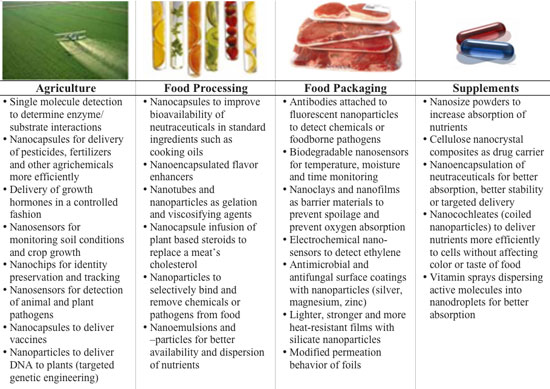| Posted: Apr 27, 2007 | |
The promises of food nanotechnology |
|
|
(Nanowerk Spotlight) Nanotechnology has begun to find potential applications in the area of functional food by engineering biological molecules toward functions very different from those they have in nature, opening up a whole new area of research and development. Of course, there seems to be no limit to what food technologists are prepared to do to our food (read this delightful romp through the food processing industry to get the idea: "Twinkie, Deconstructed |
|
| According to a definition in a recent report ("Nanotechnology in Agriculture and Food"), food is nanofood when nanoparticles, nanotechnology techniques or tools are used during cultivation, production, processing, or packaging of the food. It does not mean atomically modified food or food produced by nanomachines. | |
| Since food and agricultural sciences are mostly concerned with biological systems, and much of biology is grounded in nanoscale phenomena, the National Institutes of Health provide a more detailed definition of nanotechnology with regard to biological systems: "Only those studies that use nanotechnology tools and concepts to study biology; that propose to engineer biological molecules toward functions very different from those they have in nature; or that manipulate biological systems by methods more precise than can be done by using molecular biological, synthetic chemical, or biochemical approaches that have been used for years in the biology research community, are classified as nanotechnology projects." | |
| Here is an overview of what nanotechnology applications are currently being researched, tested and in some cases already applied in food technology: | |
 |
|
| Examples for nanofood applications (Source: Nanowerk) | |
| Let's start with where the benefits of this will be needed most: third world countries where food supply is often limited and the quality of available food leads to nutritional deficiencies and the quality of drinking water ia a major contributor to disease. In a study by the University of Toronto Joint Centre for Bioethics from two years ago ("Nanotechnology and the Developing World"; pdf), a panel of international experts ranked the 10 nanotechnology applications in development worldwide with the greatest potential to aid the poor. Number two on the list was "agricultural productivity enhancement", number three was "water treatment and remediation" and number six was "food processing and storage." | |
| Apart from funky food that changes color and taste, and glows in the dark, food nanotechnology will also lead to beneficial health effects in overfed Western countries. | |
| "The ancient Asian concept that 'food and medicine are one' has gradually also become accepted in Western countries" says Dr. Yun-Hwa Peggy Hsieh, a professor at Florida State University with a research interest in functional foods. "Foods no longer merely meet an individual?s basic physical needs, but are also expected to contribute to their health and wellbeing. Nutritional and epidemiological studies have provided strong evidence that many chronic diseases such as cardiovascular disease, diabetes, and cancer are linked to diet and the risks posed by these diet-related diseases can be reduced by the consumption of foods with extra measures of phytochemical antioxidants and with lowered fat content, especially saturated fat." | |
| In a recent article in Asia Pacific Journal of Clinical Nutrition, titled "Innovations in food technology for health" (pdf download, 176 KB), Hsieh and her colleague Jack Ofori look at a range of modern technologies applied in food production and agriculture and describe how nanotechnology is also beginning to find potential applications in this area. | |
| Hsieh points out that federally-funded nanotechnology research in food and agriculture is devoted primarily to the areas of food packaging and pathogen detection and that various innovative nanosensors for the detection of pathogenic bacteria have been developed. | |
| "Recent research, however, has begun to address the potential applications of nanotechnology for functional foods and nutraceuticals by applying the new concepts and engineering approaches involved in nanomaterials to target the delivery of bioactive compounds and micronutrients" she says. "Nanomaterials allow better encapsulation and release efficiency of the active food ingredients compared to traditional encapsulating agents, and the development of nano-emulsions, liposomes, micelles, biopolymer complexes and cubosomes have led to improved properties for bioactive compounds protection, controlled delivery systems, food matrix integration, and masking undesired flavors." | |
| Nanotechnology also has the potential to improve food processes that use enzymes to confer nutrition and health benefits. For example, enzymes are often added to food to hydrolyze anti-nutritive components and hence increase the bio-availability of essential nutrients such as minerals and vitamins. To make these enzymes highly active, longlived and cost-effective, nanomaterials can be used to provide superior enzyme-support systems due to their large surface-to-volume ratios compared to traditional macroscale support materials. | |
| An article in this weekend's New York Times Magazine "You are what you grow" shows the frightening connection between low-cost, highly processed foods and obesity and bad health. Of course there is no substitute for eating healthy, natural foods; but if food nanotechnology could contribute to making processed foods less unhealthy than this would be a tremendous success story for nanotechnology. | |
 By
Michael
Berger
– Michael is author of three books by the Royal Society of Chemistry:
Nano-Society: Pushing the Boundaries of Technology,
Nanotechnology: The Future is Tiny, and
Nanoengineering: The Skills and Tools Making Technology Invisible
Copyright ©
Nanowerk LLC
By
Michael
Berger
– Michael is author of three books by the Royal Society of Chemistry:
Nano-Society: Pushing the Boundaries of Technology,
Nanotechnology: The Future is Tiny, and
Nanoengineering: The Skills and Tools Making Technology Invisible
Copyright ©
Nanowerk LLC
|
Become a Spotlight guest author! Join our large and growing group of guest contributors. Have you just published a scientific paper or have other exciting developments to share with the nanotechnology community? Here is how to publish on nanowerk.com.
